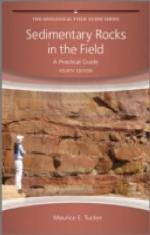|
This section contains 468 words (approx. 2 pages at 300 words per page) |

|
Sedimentary rocks form at or near the earth's surface from the weathered remains of pre-existing rocks or organic debris. The term sedimentary rock applies both to consolidated, or lithified sediments (bound together, or cemented) and unconsolidated sediments (loose, like sand). Although there is some overlap, most sedimentary rocks belong to one of the following groups: clastic, chemical, or organic.
Mechanical weathering breaks up rocks, while chemical weathering dissolves and decomposes rocks. Weathering of igneous, metamorphic, and sedimentary rocks produces rock fragments, or clastic sediments, and mineral-rich water, or mineral solutions. After transport and laying down, or deposition, of sediments by wind, water, or ice, compaction occurs due to the weight of overlying sediments that accumulate later. Finally, minerals from mineral-rich solutions may crystallize, or precipitate, between the grains and act as cement. Cementation of the unconsolidated sediments forms a consolidated rock. Clastic rocks are classified based...
|
This section contains 468 words (approx. 2 pages at 300 words per page) |

|


